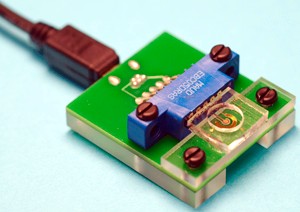Engineers at University of Cincinnati in Ohio have created a sensor that quickly detects the presence and levels of the element manganese in humans. The disposable diagnostic tool that requires just a few drops of blood is described in the August issue of the journal Biomedical Microdevices (paid subscription required).
Manganese is used to make steel, particularly to increase steel’s strength and resistance to impact in products such as railroad tracks. A study published in 2003 warns that manganese when inhaled — by welders, for example — can damage the nervous system and respiratory tract, leading to a condition similar to Parkinson’s disease.
The sensor (pictured right) is environmentally friendly in that its working electrode is made of the element bismuth instead of mercury, which is more commonly used to detect manganese. The device is also child-friendly, in that it requires only a drop or two of blood for testing as opposed to the five-milliliter sample now required in current test instruments.
The bismuth working electrode, along with the overall sensor design, also limits the effects of hydrolysis, the splitting of test molecules in the presence of water. The sensor uses a self-contained “lab-on-a-chip” design, which electrical engineering professor and team leader Ian Papautsky says can return results in about 10 minutes, instead of the usual 48 hours when samples are sent to a testing lab.
Environmental health researcher Erin Hayes, a co-author of the paper, will field test the device in Marietta, Ohio, site of the only manganese refinery in North America. The university’s Mid-Ohio Valley Air Pollution Study found elevated levels of manganese in Marietta residents when compared to those who live in other cities.
Read more: Brain Damage Potential from Welding Fumes Exposure
* * *


 RSS - Posts
RSS - Posts
You must be logged in to post a comment.